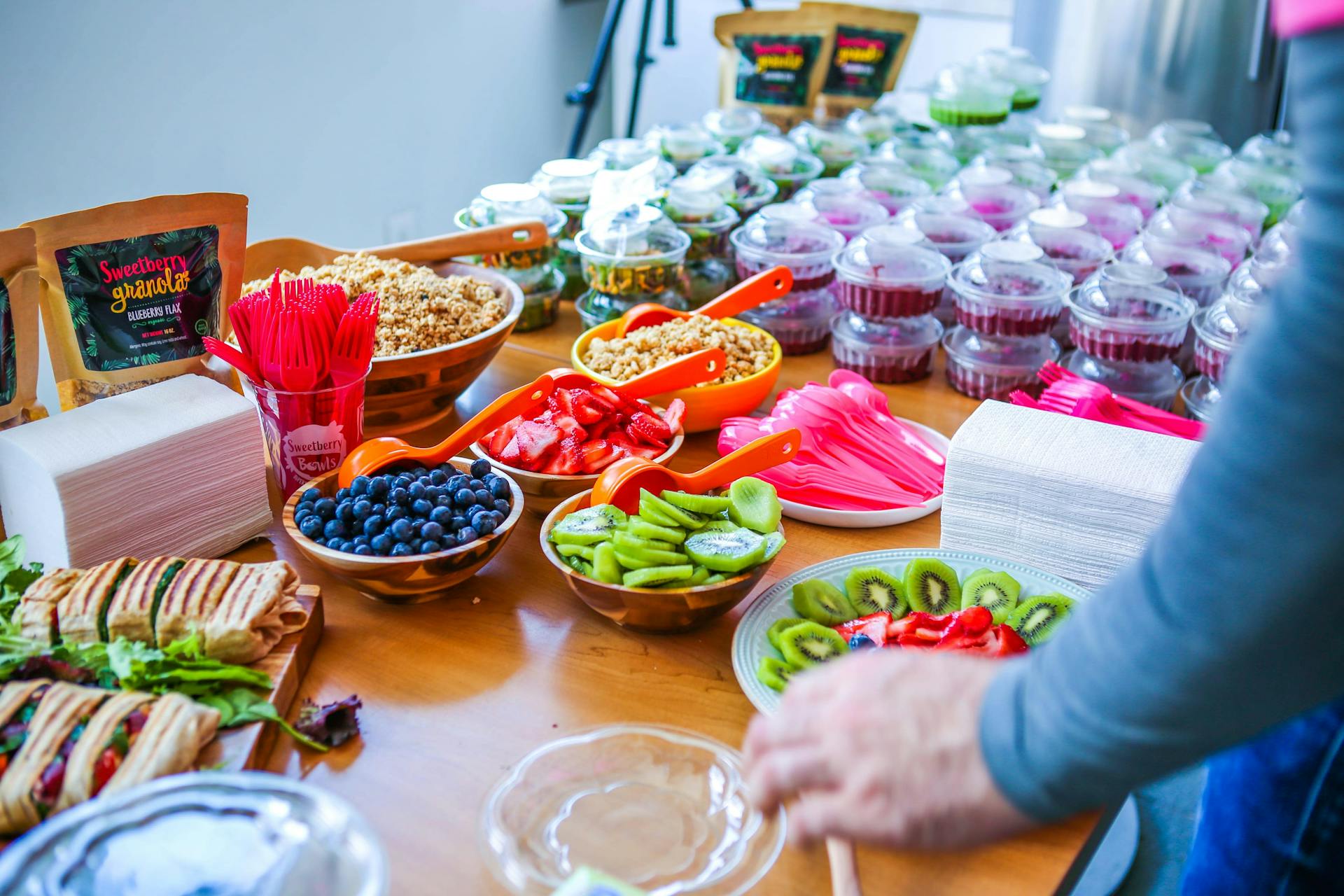
Table of contents
The U.S. catering industry generated $72 billion in revenue in 2023, and, with a projected annual growth rate of 6.2%, total revenue could reach $124 billion by 2032 (1). According to a National Restaurant Association study, 57% of adults recently used mobile ordering, reflecting how digital advances are reshaping everything from menu planning to guest engagement (2). Together, these trends reveal a food service industry in transformation, one that's growing financially while adapting technologically to meet constantly shifting consumer expectations.
Staying ahead of trends in catering has become an essential component for success. Customer preferences, sustainability priorities, and technology are all advancing quickly, and those who recognize and act on these shifts can build stronger connections with clients, open new revenue streams, and stay competitive in an increasingly crowded marketplace.
This article highlights the most influential catering trends shaping the remainder of 2025. You'll find an analysis of technology and menu innovation, evolving customer experiences, and sustainability imperatives. We'll also provide practical tips and answer commonly asked questions, so caterers, event planners, and hospitality professionals can stay relevant and excel as the catering landscape continues to evolve.
10 Catering Trends Currently Defining the Industry

Catering companies are adapting to new client expectations, technological capabilities, and market demands, reacting to shifts in the industry landscape. From sustainability imperatives to AI-powered operations, these food trends are defining how successful caterers operate and compete in the second half of 2025.
1. Sustainable Catering Practices
The Problem: Food waste and excess packaging are drawing consumer scrutiny and raising operating costs for catering companies.
The Solution: Caterers are introducing waste-reduction strategies, biodegradable packaging, and partnerships with local farms to meet both regulatory and client demands for sustainable catering. Reliable POS systems, like Otter’s, can help companies reduce waste due to their smarter inventory tracking.
Actionable Takeaway: Audit your current sourcing and packaging; prioritize compostable or reusable materials and suppliers focused on sustainable practices.
2. Personalized & Customizable Menus
The Problem: Standardized catering menus fail to accommodate diverse dietary needs and client preferences.
The Solution: Digital ordering and menu customization tools allow guests to specify dietary restrictions, cultural preferences, and unique combinations that match the event's theme. Otter POS enables instant menu edits and customizable orders, highlighting gluten-free, vegan, or allergen-conscious options while Otter Menus allows you to add appropriate labels to each item on your menu, informing guests easily.
Actionable Takeaway: Offer guests clear customization options through online ordering and train staff to handle special dietary preferences seamlessly.
3. AI-Powered Catering Management
The Problem: Manual tracking of orders, staffing, and ingredient use leads to inefficiency and errors in catering services.
The Solution: AI-driven platforms automate order intake, manage schedules, and predict demand, reducing human error and food waste while providing real-time analytics. Moreover, caterers can save money and automate upselling, helping to streamline logistics.
Actionable Takeaway: Evaluate current management tools. Adopt AI-powered solutions where possible to streamline daily operations and improve forecasting for your catering business.
4. Health-Conscious, Wellness-Focused Offerings
The Problem: Rising consumer demand for healthy, transparent food choices is outpacing menu innovation in the catering landscape.
The Solution: Catering services now offer nutrient-dense, plant-based, gluten-free, and allergen-conscious menu items, plus clean-label beverages that support wellness goals. Otter’s POS platform, for example, can track which vegan dishes are the most popular, giving catering clients access to informative stats to round out their wellness-focused dishes.
Actionable Takeaway: Refresh catering menus quarterly to integrate trending wellness ingredients like superfoods and highlight them in your marketing.
5. Experiential & Interactive Catering
The Problem: Guests want more than good food. Along with their favorite dish, diners want a memorable, interactive experience.
The Solution: Live cooking demonstrations, build-your-own bars, and interactive food stations transform event catering into an engaging element that creates lasting dining experiences. When Illinois-based Pinstripes started offering build-your-own flatbread bars at private events, the interactive experience quickly became its own experience (The Flatbread Party).
Actionable Takeaway: Test an interactive station—like taco bars or fresh pasta—at small events to create buzz and gather feedback.
6. Hybrid & Flexible Event Formats
The Problem: Shifting preferences between in-person, virtual, and hybrid gatherings make it challenging for event planners to plan and scale effectively.
The Solution: Savvy caterers offer flexible meal delivery, individualized meal kits, and tech-enabled catering services for multi-format events. During the pandemic, Foxtail developed “Foxtail at Home” catering kits for corporate meetings and virtual events, shipping individualized meal boxes nationwide.
Actionable Takeaway: Promote hybrid catering packages tailored to both remote and onsite guests to increase market reach.
7. Global Flavors & Creative Fusion Cuisine
The Problem: Demand for originality and culinary adventure can outpace traditional kitchen expertise.
The Solution: Fusion menus—think Korean tacos or Mediterranean-Japanese plates—provide excitement and keep clients engaged with global flavors. In LA, Roy Choi’s Kogi BBQ truck popularized Korean-Mexican fusion street food, with signature items like Korean short rib tacos and kimchi quesadillas, serving catered events and private bookings.
Actionable Takeaway: Add rotating international or fusion dishes as seasonal specials to test and market new catering options.
8. Tech-Enhanced Guest Experiences
The Problem: Guest engagement and satisfaction can suffer when technology isn't leveraged thoughtfully in catering experiences.
The Solution: QR code menus, digital RSVPs, live event apps, and interactive feedback tools keep guests involved and satisfaction high throughout dining experiences. Reunion Kitchen + Drink implemented QR code menus and digital ordering, just like Otter’s QR ordering, for private events and large parties, allowing guests to order, customize dishes, and give instant feedback via an event-specific app.
Actionable Takeaway: Start by integrating digital RSVPs or guest feedback into post-event follow-ups.
9. Elevated Beverage & Mocktail Programs
The Problem: Basic beverage menus fail to impress today's sophisticated guests at corporate events.
The Solution: Curated mocktails, craft cocktails, and health-conscious drinks (kombucha, infused waters) deliver more non-alcoholic options for diverse tastes and dietary preferences. Chicago’s The Aviary is known for unique beverages, and catering and offsite bar service include avant-garde mocktail and cocktail programs for both public events and private functions.
Actionable Takeaway: Work with local mixologists or beverage vendors to create unique pairings that complement your menu themes.
10. Hyperlocal & Seasonal Sourcing
The Problem: Ingredient sourcing that ignores seasonality or locality can diminish menu quality and increase environmental impact.
The Solution: Menus that showcase locally sourced and seasonal ingredients create more memorable experiences while supporting community local farms and reducing carbon footprint. In New York State, Blue Hill’s event and catering offerings gained national acclaim for “farm-to-table” sourcing, using produce, meats, and dairy from the on-site Stone Barns Center and other local partners.
Actionable Takeaway: Develop quarterly menus that highlight at least two to three locally sourced or seasonal ingredients with clear sourcing stories.
Future-proofing: What to expect beyond 2025
The catering trends shaping late 2025—from AI management to sustainable practices—represent just the beginning of a broader industry evolution. Several emerging developments are already taking shape that will redefine catering operations in 2026 and beyond.
Autonomous Catering and Delivery
Fully autonomous vehicles are moving closer to operational reality. Advances in robotics, electric vehicle fleets, and precise last-mile technology point toward a future where food delivery and setup for large events could operate with minimal human intervention. Businesses that monitor and pilot these technologies early may find opportunities for cost savings and competitive advantages as mainstream adoption grows.
Blockchain-Powered Supply Chain Transparency
Consumer demand for ingredient traceability continues to rise, particularly in corporate and institutional catering. By 2026 and beyond, blockchain solutions could make it standard to offer clients verifiable sourcing data, allowing caterers to easily share information about local farms, sustainable seafood, or allergen tracking in real time.
Predictive AI and Deep Personalization
AI capabilities are expanding beyond back-of-house logistics. The next generation of platforms is expected to predict attendance, menu preferences, and purchasing patterns, enabling caterers to hyper-personalize offerings before guests arrive. Expect AI-driven recommendations to power menu planning, staffing needs, and dynamic pricing for both small events and large-scale functions.
Immersive and Multi-Sensory Guest Experiences
The lines between food, entertainment, and technology will blur even further. Virtual and augmented reality may enhance event dining, with experiences like chef-led cooking classes in augmented environments, or virtual wine tastings that supplement in-person gatherings.
Sustainability as Standard Practice
Looking to 2026 and beyond, eco-friendly initiatives will shift from trend to requirement. Regulatory changes and client expectations are positioning zero-waste, carbon-neutral operations as the industry standard, not the exception.
Adaptability and willingness to pilot emerging solutions are essential for long-term success. The caterers who act now—investing in technology, training their teams, and building more transparent operations—will position themselves as industry leaders as new developments unfold. Keeping one eye on these future shifts while embracing today's trends ensures your catering business will help set the pace for the industry moving forward.
Frequently Asked Questions
How is AI changing catering operations in 2025?
AI streamlines catering management by automating tasks like order tracking, staff scheduling, inventory, and guest communication. Forward-thinking caterers use AI to forecast demand, improve ordering accuracy, and analyze customer preferences, boosting efficiency and reducing food waste.
What role does sustainability play in modern catering?
Sustainability is now a top priority for clients and regulators alike. Catering companies are reducing food waste, embracing eco-friendly packaging, sourcing ingredients locally, and actively measuring their environmental impact. Adopting these sustainable practices meets rising expectations and helps businesses stand out in a competitive marketplace.
Is it realistic for smaller catering businesses to adopt new technology trends?
Absolutely. Many digital tools for menu customization, online ordering, and simple inventory management are cost-effective and scale easily for small catering companies. Even modest sustainability steps, like switching to reusable packaging, offer meaningful benefits for food service operations of any size.
Which catering statistics should businesses track in 2025?
Key metrics include year-over-year booking growth, average order value, client retention rates, online ordering share, and uptake of unique offerings, like hybrid event packages. Monitoring these figures can highlight shifts in demand and operational success.
How can caterers excel at hybrid events?
Offer flexible packages that accommodate both on-site and remote attendees. Invest in digital logistics, such as order tracking and communication tools, to ensure a seamless guest experience regardless of location. Hybrid catering is also an opportunity to develop creative meal kits and virtual experiences.
How does Otter's technology support catering businesses?
Otter centralizes order management, automates scheduling and invoicing, and provides real-time analytics for improved decision-making. Its Digital Catering offering simplifies complex operations and enhances efficiency, allowing operators to focus on elevating customer experiences.
Is Otter suitable for catering businesses with multiple locations?
Yes. Otter's platform is designed for multi-location operations, offering centralized control over menus, pricing, and analytics. This enables caterers to deliver consistent quality and streamline management across all venues.

Book a demo with Otter
It’s time to enhance your operations with Otter’s all-in-one restaurant platform. Book time with our sales team to learn more.

Book a demo to see how Otter’s all-in-one platform can help your restaurant thrive.